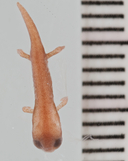|
Bolitoglossa diminuta Robinson, 1976
Subgenus: Eladinea | family: Plethodontidae subfamily: Hemidactyliinae genus: Bolitoglossa |
 © 2015 Daniel Portik (1 of 4) |
|
|
|
Description In preservative, this species has a brown dorsum with a broad midlateral light field that has scalloped edges, especially around the costal grooves, and darker flanks (Robinson 1976; Savage 2002). There may be darker lateral broad bands that pass above the forelimb insertion sites, becoming indistinguishable from the ground color once they pass over the hind limb insertion sites (Robinson 1976). Elbows and knees are not pigmented (Robinson 1976). The venter is lighter colored with scattered melanophores (Savage 2002). Ventral melanophores are dense in the cloacal region but sparse on the tip of the tail (Robinson 1976). Distribution and Habitat Country distribution from AmphibiaWeb's database: Costa Rica
Life History, Abundance, Activity, and Special Behaviors Trends and Threats Comments The specific epithet diminuta means "exceedingly small" in Spanish (Robinson 1976). This species was assigned to the genus Bolitoglossa due to the presence of 13 costal grooves and the absence of a sublingual fold (Robinson 1976). It can immediately be distinguished from other Costa Rican species due to its small size (in standard length measurement) (Robinson 1976). It is the smallest in the genus (Savage 2002). It is similar to Bolitoglossa gracilis, which has a yellowish ground color with irregular dark brown lines (Savage 2002). It also has a dark longitudinal stripe midventrally (Savage 2002). A Spanish-language species account can be found at the website of Instituto Nacional de Biodiversidad (INBio).
References
Bolaños, F. and Wake, D. B. (2009). ''Two new species of montane web-footed salamanders (Plethodontidae: Bolitoglossa) from the Costa Rica-Panamá border region.'' Zootaxa, 1981, 57-68. Bolaños, F., Wake, D., and Savage, J. 2008. Bolitoglossa diminuta. In: IUCN 2009. IUCN Red List of Threatened Species. Version 2009.2. www.iucnredlist.org. Downloaded on 04 December 2009. Robinson, D. C. (1976). ''A new dwarf salamander of the genus Bolitoglossa (Plethodontidae) from Costa Rica.'' Proceedings of the Biological Society of Washington, 89(22), 289-294. Savage, J. M. (2002). The Amphibians and Reptiles of Costa Rica:a herpetofauna between two continents, between two seas. University of Chicago Press, Chicago, Illinois, USA and London. Originally submitted by: Mae Huo (first posted 2009-11-02) Edited by: Kellie Whittaker (2019-03-06) Species Account Citation: AmphibiaWeb 2019 Bolitoglossa diminuta <https://amphibiaweb.org/species/3969> University of California, Berkeley, CA, USA. Accessed May 29, 2025.
Feedback or comments about this page.
Citation: AmphibiaWeb. 2025. <https://amphibiaweb.org> University of California, Berkeley, CA, USA. Accessed 29 May 2025. AmphibiaWeb's policy on data use. |



 Raffaëlli Account
Raffaëlli Account Map of Life
Map of Life